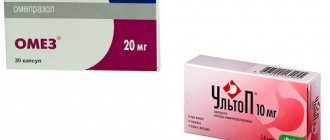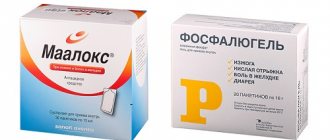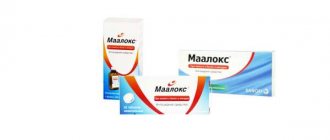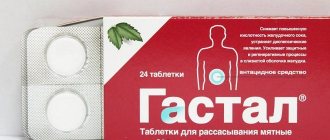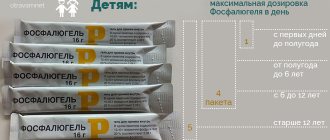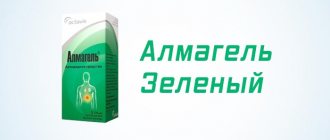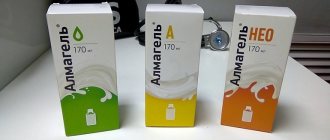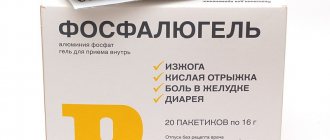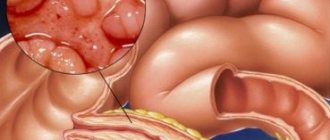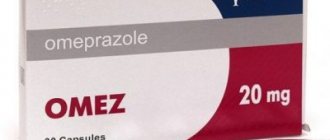Advantages of Phosphalugel over similar drugs
The main advantage of the product is that the active component reduces acidity, however, does not leach gastric juice. This ensures the prevention of secondary acid release into the gastrointestinal tract. Antacids are an emergency remedy for people with heartburn, stomach ulcers, and gastritis. The medication is well tolerated and can be used by patients of all age groups.
Comparison with other similar drugs
The active substance of Phosphalugel, aluminum phosphate, exhibits antacid, absorbent, and enveloping properties. Under the influence of the gel, the acidity of the stomach is normalized. The active substance interacts with hydrochloric acid, reducing acidity levels. Forms a protective film on the inner surface of the gastrointestinal tract, regenerates mucous membranes. The medicine absorbs and removes poisonous substances: toxins, pathogenic microorganisms and their waste products.
If a doctor prescribes a structural analogue of a gel with a similar active ingredient, the product will exhibit similar pharmacological properties. If the patient cannot use aluminum phosphate, the doctor may recommend the use of:
- Maaloxa.
- Gaviscon.
- Gastala.
- Omeza.
- De-Nola.
- Omeprazole.
- Pepsana.
- Enterola.
- Motilium.
- Almagel.
- Almagel-Neo.
They recommend both exact structural analogues and medications from a similar pharmacological group, but with a different active component.
The described medications have a different mechanism of action, but have indications for use similar to Phosphalugel. The main difference is the composition. Before starting use, it is recommended to consult a doctor to agree on the dosage, frequency and duration of use of the medicine. It is necessary to compare drugs, pay attention to contraindications and method of use.
Which is better: Almagel or Phosphalugel
Phosphalugel and Almagel are representatives of the same pharmacological group with different compositions. Both medications are recommended for patients with the following diseases:
- gastritis;
- ulcerative lesions of the gastrointestinal tract;
- diaphragmatic hernia;
- reflux esophagitis;
- functional digestive disorders, accompanied by diarrhea, constipation, flatulence, pain in the abdominal area.
Medicines protect the gastric mucosa from the negative effects of other groups of drugs (NSAIDs), as well as ethanol.
Phosphalugel differs from Almagel in the following points:
- more affordable cost;
- the possibility of treating newborn children;
- use by pregnant and lactating women;
- normalization of the functional state of the gastrointestinal tract;
- the pharmacological effect appears more slowly.
If emergency assistance and quick elimination of pain are necessary, the use of Almagel is recommended.
Phosphalugel can be given to newborn babies, while Almagel is used from 10 years of age. The list of contraindications for Almagel is more extensive. If Phosphalugel has hypersensitivity reactions and severe kidney dysfunction, then the manufacturer of the second drug additionally notes:
- period of bearing a child;
- Alzheimer's disease;
- individual intolerance to components, including fructose.
Both remedies are not intended for self-medication and can be used on the recommendation of a gastroenterologist.
Maalox and Phosphalugel - comparison
Maalox is an antacid drug based on hydrated aluminum. It is well absorbed and tolerated by patients and is prescribed to pregnant women. Maalox has a wider range of dosage forms: suspension, lozenges. Tablets and suspension are more expensive than Phosphalugel. Recommended for patients over 15 years of age. The indications for both drugs are similar. Maalox is recommended for patients with the following pathologies:
- exacerbation of gastric ulcer;
- diaphragmatic hernia;
- gastroduodenitis (normal/increased secretory function) at any stage of development;
- reflux esophagitis;
- dyspeptic disorders.
The best option for pregnant and lactating women, as well as patients who are faced with increased acidity of gastric juice, is Phosphalugel. A budget drug that works effectively, quickly, and is inexpensive.
Choosing between Gaviscon and Phosphalugel
Gaviscon is a substitute antacid with a multicomponent composition. Available in the form of a suspension and lozenges. Quickly eliminates heartburn and stomach pain. Envelops the mucous membrane, accelerates the process of its regeneration, and prevents gastroesophageal reflux. The main indication is the treatment of patients with reflux esophagitis, heartburn, belching, dyspeptic disorders, and hiatal hernia. For gastric ulcers, it is used as a symptomatic remedy and does not always exhibit the proper therapeutic effect. Tablets and bags of suspension can be used up to 7-8 times a day. The medicine is not intended for long-term use.
Gaviscon is not used if you are hypersensitive to the active ingredients. Tablets are not used to treat patients under 12 years of age. Pregnant women can use both medications.
Enterosgel
Enterosgel is a drug with absorbent properties that is prescribed to patients with various types of intoxication. Available in the form of a paste for internal use. This medicine is not cheap: 390 rubles for 225 grams. The drug of choice for acute and chronic poisoning. Binds and removes toxic substances, allergens, pathogenic microorganisms. It differs from the gel in composition, mechanism of action, pharmacological properties, and indications for use. This drug cannot replace antacid medications.
Patients often ask: Phosphalugel or Enterosgel: which is better? Both drugs can be used in complex treatment regimens on the recommendation of a doctor.
Which drug to choose: Phosphalugel or Omez (Omeprazole)
Omeprazole is a domestically produced medicine that belongs to the group of proton pump inhibitors (PPIs). Phosphalugel is a means of symptomatic therapy, while Omez acts on the root cause of the disease. The drugs differ in group, composition, mechanism of action, but have similar indications for use. Can be used together in complex treatment protocols.
A proton pump inhibitor inhibits the synthesis of hydrochloric acid. The antacid neutralizes the already produced acid, reducing its aggressive effect. At the same time, the gel does not affect the process of hydrochloric acid production. The combination of antacids and PPIs can improve the expected therapeutic effect and speed up the patient's recovery process. It is recommended to maintain an interval of at least several hours between the use of these groups of products.
Polysorb and Phosphalugel - the difference between the drugs
Polysorb is a product from the group of enterosorbents, which is available in powder form for oral administration. It works thanks to silicon dioxide, which is active against acute or chronic intoxication. Copes with intestinal dysbiosis, allergies, and is prescribed to patients of all age groups.
Polysorb and Phosphalugel are representatives of different pharmacological groups. The gel has a large list of pharmacological properties, including sorption properties. The funds cannot be called interchangeable. However, in case of severe poisoning or functional disorders of the gastrointestinal tract, the doctor may recommend a combination of a sorbent with an antacid.
As doctors joke, there are no healthy people, only underexamined ones. Unfortunately, almost every second of us has certain problems with the gastrointestinal tract.
Some people have known gastritis since childhood, others suffer from heartburn. Stomach diseases manifest themselves in different ways. Almagel and Phosphalugel have probably helped each of us cope with an intestinal illness at least once in our lives.
Comparison of antacids, choosing the best
Almagel
Almagel, as the most common representative of the group under consideration, contains 4.75 grams of gel and 0.1 g of magnesium oxide per 5 ml of oral suspension. Some types of Almagel contain anesthesin in a dose of 0.1 g per 5 ml. This allows you to achieve an anesthetic effect. Externally, the medicine is a white, opaque liquid. During long-term storage, solid fractions settle at the bottom of the container. It is recommended to shake the bottle thoroughly before taking it.
Almagel is one of the first drugs in the group of drugs for heartburn with high acidity. Its development took place in the 60s of the 20th century. More modern products have been created based on aluminum hydroxide.
The effect of all local antacids is generally similar. The above description of the pharmacological effects is relevant not only for aluminum salts, but also for other agents to reduce the acidity of gastric contents.
We advise you to read: Indications for use Almagel.
Phosphalugel
Phosphalugel is an aluminum-based medicine that has antacid and gastroprotective effects. Available in gel form for internal use. Indicated for peptic ulcers, gastritis, diarrhea and other diseases of the gastrointestinal tract. Can be used in conjunction with De-nol and other etiotropic drugs.
When choosing between two drugs, the doctor focuses on the following differences:
| Medicine | Phosphalugel | Almagel |
| Compound | Aluminum phosphate + Pectin + Agar-Agar | Aluminum hydroxide + Magnesium oxide + D-sorbitol + Anestezin |
| Release form | Packages of 16 and 20 ml, gel | 170 ml bottles, suspension |
| Method of use | Dissolve in half a glass of warm water | In its purest form |
Another significant factor influencing the choice of medication is the patient's financial situation. The price difference is quite large. For Phosphalugel you will have to pay about 500 rubles. Almagel is noticeably cheaper - its price starts from 150 rubles in Moscow pharmacies.
Maalox
Maalox is one of the closest structural analogues of Almagel
Maalox is the drug closest to Almagel. One medicine can be freely replaced by another. One dosage sachet contains 525 mg of Aluminum hydroxide and 600 mg of Magnesium hydroxide. D-sorbitol and Anestezin are not present in the drug. The dosage of the active ingredients differs from Almagel. Externally, the product looks like a white liquid with a characteristic mint odor. Distributed in 15 ml sachets or in the form of chewable tablets.
Adult patients are prescribed 6 packets per day. For comparison, Almagel is used 2 teaspoons 4 times a day. The cost of both products is comparable and starts from 150 rubles. For a pack of Maalox chewable tablets you need to pay 220 rubles. When choosing Maalox or Almagel, you should focus on the preferences of the doctor and the patient. There is no significant difference in the pharmacological action of the drugs.
Gaviscon
Gaviscon differs markedly in chemical composition.
It includes the following substances:
- sodium alginate – 500 mg;
- calcium carbonate – 160 mg;
- baking soda – 267 mg.
The dosage is indicated per 10 ml. The product is available in the form of a white suspension with a mint odor, as well as in the form of chewable tablets. Used primarily for the treatment of reflux esophagitis. For peptic ulcers it is ineffective. Due to the high soda content, it can cause slight bloating, which distinguishes it from Almagel. Prescribed 80 ml per day. The dose is divided into 4-6 doses. Consumed in its pure form. According to online pharmacies, the cost of Gaviscon starts at 126 rubles.
Gastal
Gastal is available in the form of a suspension (Gastal-liquo) and in the form of lozenges. The tablet form is more common and is available in Croatia, Poland and Israel. Only the Israeli company is engaged in the production of the suspension. With 1 tablet it is possible to neutralize 21.5 mmol of hydrochloric acid. Prescribed 1 tablet 6 times a day. Dosage regimen: 30-60 minutes after meals. Almagel, in turn, is used 30 minutes before meals.
The duration of the course is 2 weeks versus 3-4 weeks for Almagel. Cost – 180-450 rubles, depending on the dosage form and package size. During treatment, constipation may develop, which is treated symptomatically.
Not all medications used for digestive disorders are interchangeable; for example, Smecta differs from Almagel in its mechanism of action and indications.
Alumag
The only manufacturer of Alumag is Polish. Available in tablet form. 1 tablet contains 200 mg of aluminum hydroxide and a similar amount of magnesium hydroxide. It is practically not absorbed from the gastrointestinal tract; 2 tablets are prescribed three times a day. Course duration – 3 weeks. Impairs the absorption of other drugs. At least 1-2 hours should pass between taking Alumag and systemic agents.
The product is considered outdated and is rarely found on sale. It is better to use modern medicines. The cost of the drug is 50-80 rubles.
Omez
Omez is a systemic agent
The drugs are functional analogues, but differ fundamentally in their mechanism of action and chemical composition. Omez is a drug with systemic effects. Available in the form of enteric capsules. Each of them contains 10 mg of Omeprazole. Belongs to the group of proton pump inhibitors, is absorbed into the systemic circulation, reduces the secretion of hydrochloric acid by the parietal cells of the stomach. In this case, neutralization of already secreted gastric juice does not occur.
Comparative table of pros and cons of various antacids
| A drug | pros | Minuses |
| Almagel | There are several types that have not only an antacid, but also a carminative (Almagel Neo) and analgesic effect (Almagel A). Release form: suspension. | Contraindicated for children under 10 years of age, women during pregnancy and lactation. Causes constipation, changes in taste. Long-term use is fraught with a decrease in bone mineralization. Should not be prescribed for Alzheimer's disease or severe renal impairment. |
| Alumag | Allowed during breastfeeding. It is well tolerated; it is extremely rarely accompanied by side effects. | Causes bowel problems (diarrhea or constipation). Long-term use sometimes leads to phosphorus deficiency in the body. Contraindicated in children under 15 years of age, patients with fructose intolerance, and impaired renal function. |
| Gaviscon | It is produced in two forms: tablets and suspension. It has a pleasant lemon or mint scent. Approved for use in pregnant women and children over 6 years of age. | While taking it, allergic manifestations are possible in the form of bronchospasm, rash, urticaria, itching, anaphylaxis. |
| Gastal | It has a high antacid effect and does not cause constipation. Can be used to treat hyperphosphatemia. | Contraindicated in case of insufficiency of renal function. With prolonged use of high doses, the development of hypophosphatemia and hypercalciuria, softening of bone tissue in elderly patients is possible. |
| Gastracid | Quickly eliminates heartburn and stomach pain, has a protective, enveloping and adsorbing effect. Has a pleasant mint taste. Does not stimulate secondary hypersecretion of hydrochloric acid and alkalosis. | May cause side effects from body systems. Contraindicated in patients with sucrase/isomaltase deficiency, fructose intolerance, glucose-galactose malabsorption, hypophosphatemia, and impaired renal function. Not prescribed for children under 10 years of age, patients with Alzheimer's disease, or pregnant women. |
| Gelusil | Has an adsorbing and enveloping effect. Protects the gastric mucosa from aggressive factors. Does not cause secondary hypersecretion. | Leads to constipation. In patients with impaired renal function, long-term treatment may increase the concentration of magnesium ions in the blood. Contraindicated during pregnancy, lactation, and under 10 years of age. |
| Maalox | Available in two forms (tablets and suspension). Has high acid-neutralizing ability. Has a protective, adsorbing and enveloping effect. Eliminates pain in the upper gastrointestinal tract. Well tolerated. | Contraindicated in chronic renal failure, pregnancy, Alzheimer's disease, hypophosphatemia. Not recommended for children under 12 years of age, women during pregnancy and breastfeeding. |
| Relzer | Reduces gas formation in the intestines. Does not cause secondary acid hypersecretion. Has a gastroprotective effect. Stimulates the regeneration of the gastric mucosa, increases the quantity and improves the quality of mucus. Relieves spasm, reduces pain. Rarely provokes adverse reactions. | Contraindicated in patients with fructose intolerance and hypophosphatemia. Do not take if you have Alzheimer's disease or severe renal impairment. Contraindicated for children under 10 years of age. |
| Rennie | Available in different flavors: mint, menthol, orange. It has an antacid and gastroprotective effect, increases mucus formation. Helps quickly reduce acidity and eliminate pain. Well tolerated by patients. Allowed during pregnancy and lactation. | While taking it, there is a change in the consistency of stool, and diarrhea is possible. Provokes a compensatory increase in gastric juice production. If the functional activity of the kidneys is impaired, it can lead to the development of hyperkalemia and hypermagnesemia. |
| Rutacid | The effect of the drug depends on the initial level of acidity. It brings it back to normal without causing an excessive decrease. Helps protect the stomach walls. Does not penetrate into the tissues of the nervous system or bone tissue. Can be used in pregnant women. | While taking it, allergic reactions, diarrhea, and belching are possible. Do not take in case of acute renal failure or under 6 years of age. |
| Talcid | Promotes a rapid and long-lasting reduction in stomach acidity to natural levels. It has a gastroprotective effect, activates gastric protective factors. Does not affect the concentrations of aluminum, magnesium, mineral composition and other blood parameters (hematocrit, hemoglobin levels, leukocytes, urea). | During therapy in high doses or taken for a long time, stool disorders (frequent loose bowel movements) and digestion are possible. Not recommended for impaired renal function. |
| Phosphalugel | It has an enveloping effect, promotes the protection and regeneration of the gastric mucosa. Reduces the activity of the pepsin enzyme, binds lysolecithin and bile acids. Maintains physiological conditions of digestion. Does not stimulate secondary hypersecretion of gastric juice or changes in electrolyte balance. Can be used for children from 6 months. | Contraindicated for abdominal pain of unknown etiology, constipation, chronic diarrhea, Alzheimer's disease. |
For acid-related gastrointestinal diseases, antacids are not used as often as PPIs. They are prescribed mainly as symptomatic auxiliaries or when increased acidity is episodic.
To choose which antacid is better, you need to pay attention to the composition. Preparations containing magnesium compounds (oxide, hydroxide, carbonate) and aluminum (oxide, phosphate) are characterized by a slow onset of effect (up to 30 minutes) compared to drugs based on sodium and calcium. However, their significant advantage is the duration of action (2.5 – 3 hours). They are not absorbed into the systemic circulation, so they have fewer side effects.
Aluminum preparations contribute to the development of constipation, as they slow down intestinal motility, so they are not suitable for patients prone to constipation. Antacids based on magnesium salts, on the contrary, accelerate intestinal motility and loosen stools.
Calcium and sodium preparations begin to have a therapeutic effect within a few minutes, which is their main advantage. However, the decrease in acidity does not last long. In addition, they provoke an acid rebound - a compensatory increase in acidity after the drug wears off. Another disadvantage is the formation of CO2, which stretches the walls of the stomach and causes belching and flatulence.
Preparations containing sodium or calcium carbonates can lead to an imbalance in the acid-base balance in the body. Antacids based on calcium salts can lead to the formation of calcium kidney stones.
When choosing drugs, you should pay attention to the release form. They begin to act only in a dissolved state. From this point of view, it is better to choose suspensions. They contain small particles of active substances, so they dissolve faster than tablets, which must first be dissolved for a long time. However, the suspension is not very convenient to use. For example, in public places it is much easier to take a tablet than to drink a suspension.
The doctor must decide which drug will be better in each specific situation. Only he will be able to take into account all the nuances of the patient’s condition, assess the benefits and possible negative consequences.
What is Phosphalugel and how to take it
Phosphalugel - this gel is good for those who often suffer from heartburn or other similar discomforts. Such unpleasant sensations can arise as a result of a person overeating at the holiday table.
Gastroenterologists prescribe this drug for exacerbation of gastritis, as well as in the presence of a chronic form of the disease.
For peptic ulcers of the intestines and stomach, for symptoms that are characteristic of poisoning (food poisoning can be different: after drinking low-quality alcohol or excessive amounts, after eating low-quality food), severe pain in the abdomen, with nausea (especially that which occurs after how stale food gets into the body), with heartburn.
Indications for starting a course of Phosphalugel also include the following diseases:
- peptic ulcer of the stomach or duodenum;
- reflux esophagitis;
- gastroesophageal reflux (and other unpleasant sensations that are accompanied by sour belching);
- non-ulcerative dispensation syndrome;
- colon diseases
- in case of poisoning with low-quality products.
Despite the fact that at first glance this drug seems harmless, it should not be taken by people suffering from Alzheimer's disease, those with poor kidney function, heart and vascular diseases, or a diseased liver.
Before taking the drug, you should clarify all the components of the composition so as not to get an allergy.
Phosphalugel is available without a doctor's prescription, but you should not self-medicate. Consult a gastroenterologist first.
The medicine must be taken before meals, about thirty minutes. An important difference between this medicine is the way it is taken - the drug is not taken with food or after a meal. A gastroenterologist should warn you about special conditions for taking the medicine.
For duodenal ulcers, the medicine should be taken only a few hours after the last meal. For gastritis, take the medicine before meals. If severe pain occurs, take Phosphalugel immediately.
Duration of treatment is up to one week.
Before taking the gel, it must be kneaded in a bag until the contents are homogeneous. Tear the sachet and squeeze the gel through the resulting hole into a spoon or directly onto the tongue.
Phosphalugel
Phosphalugel, like Almagel, belongs to the group of antacids. Produced by the French pharmaceutical company Astellas.
Composition and release form
The first difference between Phosphalugel and Almagel is its composition. The active ingredient here is aluminum phosphate gel - 12.38 g. Auxiliary ingredients: sorbitol, potassium sorbate, flavoring, water, calcium sulfate, pectin.
Available in the form of a gel for oral use. The gel is creamy white with an orange aroma.
pharmachologic effect
There is some difference between Phosphalugel and Almagel in action. Aluminum phosphate also neutralizes excess acidity, coats and protects mucous membranes. But at the same time, as the manufacturer claims, there is no rebound effect. This effect is known because after the use of antacids, excessive secretion of gastric juice occurs again.
The use of the drug does not cause electrolyte imbalance and the formation of stones in the urinary tract. Performs a protective function, preventing the harmful effects of nicotine, alcohol and medications on mucous membranes.
Who is the drug indicated for?
Phosphalugel is prescribed for ulcerative pathologies of the intestines and stomach, acute and chronic gastritis , hiatal hernias and gastroesophageal reflux disease .
It is used for functional diarrhea and dyspepsia, digestive disorders caused by infection, poisoning, drugs or irritants.
Used to eliminate stomach pain, heartburn, belching, flatulence as a result of poor diet, excessive coffee consumption or smoking.
Contraindications
When choosing which is better: Phosphalugel or Almagel, you should pay attention to the fact that Phosphalugel has slightly fewer contraindications. These include hypersensitivity, severe abdominal pain, constipation and chronic diarrhea and Alzheimer's disease.
Adverse reactions
Constipation sometimes develops, especially in bedridden patients. The development of diarrhea can be caused by sorbitol; allergic reactions were observed only in patients with individual hypersensitivity.
Almagel - an alternative to Phosphalugel?
One of the closest competitors of Phosphalugel is Almagel. Due to its enveloping effect, the drug is prescribed to reduce acid in the gastric tract and combat abdominal pain.
The main function of the drug is an anesthetic effect that reduces pain.
The unique composition of Almagel helps get rid of constipation (even the most severe). The effect of the drug on the body is mild and almost instantaneous.
Almagel is prescribed by a gastroenterologist for chronic forms of gastrointestinal ulcers, during exacerbations of diseases, gastritis, acid levels, poisoning, increased gas formation, or a hernia in the abdominal cavity.
Poor nutrition, dieting (when you want to lose ten kilograms in two days), as well as abuse of spicy or fatty foods, excessive consumption of coffee and alcoholic beverages - the doctor will prescribe the same Almagel (or, in extreme cases, Maalox).
Diseases for which a gastroenterologist will prescribe a course of treatment with Almagel include:
- acute exacerbation of gastritis (with increased acidity);
- peptic ulcer;
- digestive tract hernia in the diaphragm;
- duodenitis;
- esophagitis;
- poisoning of various types from low-quality food or drinks;
- increased flatulence;
- discomfort after overindulging in food or drinks;
- as prevention of peptic ulcer disease.
Contraindications for prescribing and taking this drug are Alzheimer's disease, liver and kidney diseases, constipation, pregnant and lactating women, chronic diarrhea. Also, the drug is not recommended for infants, children under 12 years of age and the elderly.
Almagel is currently produced by several pharmaceutical concerns. The price of their drugs differs. For example, a drug produced by a Bulgarian pharmaceutical concern will be the cheapest on the drug market.
Let us give you a little advice - buy medicines from those manufacturers who are least likely to be counterfeited.
Analogs
The pharmaceutical market offers a wide range of drugs that are similar in action to Phosphalugel and Maalox. However, analogues do not completely copy them. Among the popular ones are:
- De-Nol. The drug has an antiseptic effect on the stomach and has an astringent and enveloping effect. Usually taken in combination with other drugs. Experts do not recommend this medication to women during pregnancy and lactation. The tablets should not be given to children under 4 years of age.
- Omez. Its main advantage is reducing stomach acidity and relieving heartburn. Can help cure gastrointestinal diseases, including stress ulcers and reflux esophagitis. For gastritis, Omez is used together with 2 antibiotics, for example, Amoxicillin and Clarithromycin. But, again, the drug is prohibited for pregnant and lactating women and young children.
- Enterol. The product can replace Phosphalugel, but only if a person suffers from diarrhea caused by helminthic infestation or other infectious processes in the gastrointestinal tract. The medicine has antidiarrheal properties. An absolute plus of Enterol is that the risk of overdose is minimal.
Almagel or Phosphalugel - which is better?
What helps better - Almagel or Phosphalugel?
Despite its effectiveness and good recommendations, Phosphalugel is not the cheapest drug today. Therefore, people with limited financial resources are looking for an alternative. Compromise options include Almagel, Gastal and Maalox.
There is no definite answer - which drug will work better and which will work worse.
These medications differ in the form of release - some are produced in the form of a gel (Phosphalugel), others are packaged as a suspension (Almagel suspension even has an orange flavor), others have different packaging forms - tablets, suspensions and sachets (Maalox).
The doctor will select the medicine depending on the patient’s age and personal preferences (adults like the gel; children are best given the suspension). Suspensions also contain magnesium and aluminum hydroxide.
While taking Phosphalugel, the concentration of phosphorus in the blood does not decrease, and calcium is not washed out of the bones. This should be taken into account when taking these drugs for a long time.
For a short course of therapy or prevention, Almagel is best suited; for a long course of treatment, gastroenterologists recommend Phosphalugel.
Almagel and Phosphalugel, according to the classification of pharmacologists, belong to the group of antacid drugs. Their main effect is to neutralize the effect of gastric juice.
Thanks to the main active ingredient, the amount of hydrochloric acid in the patient’s gastric juice is reduced for a long time.
In addition, medications have an anesthetic effect. Mild side effects include a slight laxative effect. Gastroenterologists also prescribe these drugs as a choleretic agent.
The drugs are also based on aluminum hydroxide, which, once in the stomach, is mixed with hydrochloric acid. As a result, the mixture turns into acid-neutralizing aluminum chloride.
Magnesium hydroxide (present in medications) combines with hydrochloric acid in the stomach to form magnesium chloride, which causes constipation.
Medicines Almagel, Phosphalugel, Gastal, Maalox and others normalize and maintain the acid level in the human gastrointestinal tract.
Almagel is a time-tested remedy that helps quickly get rid of heartburn, sour belching and pain in the epigastric region. The composition of the pharmacological drug includes ingredients that have a mild effect on the human body. This determines a small number of contraindications and side effects, allowing it to be used in the treatment of young children and women while pregnant. But do not forget that Almagel is a medicine, so before using it you should consult a gastroenterologist.
Manufacturers produce Almagel suspension in three types, which differ in composition and scope of application
Comparison of effectiveness: Phosphalugel and Maalox
When choosing a medicine, we often compare the effectiveness of similar drugs presented by pharmaceutical companies. In terms of their functions, the suspensions discussed above have many similar actions. However, despite the fact that both drugs belong to the same group of substances with antacid properties, there are differences between Phosphalugel and Maalox. For example, the indications for use of the first gel are wider than those of the second.
Phosphalugel is prescribed to patients as a therapy for a particular disease, and Maalox will help every person cope with the errors of poor diet (heartburn) or lifestyle (smoking, alcohol).
The difference between the two products is also in the form of release: the gel envelops the walls of the gastrointestinal tract, and is especially effective for gastritis caused by Helicobacter pylori infection, cases of formation of erosions and ulcers on the mucous membrane of the stomach and intestines. Whereas Maalox, presented in the form of a suspension or tablets, acts centrally against esophagitis (damage to the mucous membrane of the esophagus, which is accompanied by inflammation).
Phosphalugel is prescribed for the complex treatment of diseases of the stomach and intestines. The key goal is to reduce the concentration of acid and promote the restoration of the mucous membrane of the diseased organ.
In terms of the rarity of adverse reactions, Phosphalugel is the leader.
Tolerability of drugs
When comparing the presented medications, it is worth paying attention to their tolerability by patients. The list of contraindications for Maalox is wider than that of Phosphalugel. However, both drugs can cause individual reactions. This fact should certainly be taken into account at the very beginning of treatment with one of the remedies. By the way, the effect of drugs and the process of their absorption are also influenced by the patient’s chronic pathologies.
Judging by the reviews, the drug Maalox is able to cope with heartburn, but is not suitable for constant use, as it causes digestive upset. There are patient complaints of diarrhea or constipation. Excessive use of Phosphalugel also causes disorders, but the percentage of such adverse reactions is much lower than that of Maalox.
Age restrictions
When using Phosphalugel or Maalox, it is worth considering the age of the patient. The pharmaceutical companies that produce Maalox have not studied the therapeutic effect of the drug in children. Therefore, the main contraindication to the use of this drug is age under 15 years. At the same time, Maalox can be safely taken by adults and elderly patients. True, for this it is important, first of all, the normal functioning of the kidneys.
Phosphalugel is indicated for a wide range of patients, including newborns for appropriate indications. However, it is worth calculating the exact dosage for young children and subsequent monitoring of treatment.
For elderly patients, Phosphalugel is also indicated for use if the kidneys are functioning normally.
These medications should be used with caution, as long-term use can cause calcium to be washed out of the body.
By the way, the tablet form allows you to store the drug longer, which cannot be said about suspensions and gels. In addition, on the medicine market you can find special Maalox tablets that do not contain sugar. This means that the drug is suitable for people with diabetes.
Composition and release form
Manufacturers produce Almagel in the form of a suspension with a pleasant taste and lemon aroma. The primary packaging of the drug is a 170 ml dark glass bottle, which is accompanied by a plastic spoon for convenient dosing. The drug contains the following ingredients:
- aluminum hydroxide;
- magnesium hydroxide;
- saccharin in the form of a sodium compound;
- hyaetellosis;
- methyl parahydroxybenzoate;
- propyl parahydroxybenzoate;
- butyl parahydroxybenzoate;
- sorbitol;
- lemon flavor;
- ethanol;
- distilled water.
Types of medicine
On the shelves of pharmacies, the therapeutic line of Almagel is represented by four types of antacids, differing from each other in the qualitative and quantitative content of ingredients. Each drug is intended to treat certain forms of gastritis and ulcerative lesions. What types of Almagel are there:
- Almagel in green packaging. The suspension contains all of the above ingredients. The drug is used for the treatment of gastritis occurring against the background of excessive production of hydrochloric acid by glandular cells;
- Almagel A in yellow packaging. The composition of the suspension is supplemented with the anesthetic benzocaine. Almagel A is used in the treatment of diseases of the digestive system, accompanied by the development of pain;
- Almagel Neo in orange packaging. The suspension contains simethicone, which allows the drug to be used in the treatment of pathologies that provoke increased gas formation. Almagel in bags is available in a single form - with simethicone.
There is also a tablet form of the drug - Almagel T No. 12 and No. 24. It contains one active ingredient, magaldrate.
Advice: “Almagel Neo in sachets or Almagel T tablets are convenient to take with you to work and on long trips. And the suspension in a dark bottle is suitable for people who are undergoing a long course of treatment due to its more favorable price.”
pharmachologic effect
Thanks to the combined balanced composition, Almagel exhibits diverse therapeutic effectiveness:
- absorbent;
- pain reliever;
- tread;
- antacid;
- laxative.
After penetration into the stomach cavity, aluminum hydroxide enters into a chemical reaction with hydrochloric acid to form neutral end products. The chemical compound has the ability to block the production of pepsin, a digestive enzyme produced by the mucous membrane. Magnesium hydroxide is also involved in the reactions of neutralizing gastric juice. But its main pharmacological effect is to increase the motility of the digestive tract, which occurs under the influence of aluminum hydroxide.
All forms of Almagel release are capable of restoring damaged stomach tissue, normalizing the synthesis of prostaglandins. The drug forms a protective film on the mucous membrane that prevents the effects of hydrochloric acid and pepsin on ulcerations, wounds and microcracks. The drug penetrates into the systemic circulation in extremely small quantities. Almagel begins to work immediately after entering the stomach, and its rate of elimination from the body depends on the quality and quantity of food in the gastrointestinal tract.
Indications for use
Useful article? Share the link
Gastroenterologists recommend using Almagel for patients diagnosed with gastrointestinal pathologies manifested by dyspeptic disorders. These include nausea, vomiting, sour belching, chronic constipation or diarrhea. Indications for use of Almagel are:
- bacterial and viral intestinal infections;
- gastritis, accompanied by increased production of gastric juice;
- ulcerative lesions of the gastrointestinal tract;
- poisoning by poisons of plant and animal origin, alkalis and acids, heavy metals;
- prevention of relapses of chronic gastritis.
Almagel with an analgesic effect is used in the treatment of patients suffering from epigastric pain after eating food.
Recommendation: “All types of medications are indicated for patients taking non-steroidal anti-inflammatory drugs. Almagel prevents damage to the mucous membranes of the stomach and intestines while taking NSAIDs.”
Almagel
A combined antacid drug used for various pathologies of the gastrointestinal tract. Produced by the Bulgarian pharmaceutical company Balkanfarma.
Composition and release form
Available in the form of a suspension for oral use. One 5 ml dosage spoon contains 2.18 g of aluminum hydroxide gel and 350 mg of magnesium hydroxide paste. Auxiliary components are sorbitol, parahydroxybenzoates, sodium saccharinate, lemon oil, ethyl alcohol and purified water.
170 ml of suspension and a dosage spoon are dispensed in dark glass bottles. The bottle can also be polymer with a similar volume.
pharmachologic effect
Almagel, like Phosphalugel, is a medicinal group of antacids . Their action is based on neutralizing excess hydrochloric acid and reducing the effect of pepsin. At the same time, the digestive activity of gastric juice decreases. The drug has an adsorbing and enveloping effect.
The protective effect helps prevent inflammatory and erosive damage to the gastric mucosa, for example, after taking alcohol or drugs that irritate the stomach - aspirin, corticosteroids and others.
Indications for use
Almagel is prescribed for any form of gastritis, inflammation of the intestinal mucosa, colitis and enteritis, and peptic ulcers of the digestive tract. Also used for hiatal hernias, ulcers and erosions of the upper digestive tract.
Prescribed for exacerbation of pancreatitis or its chronic form, as a prevention of intestinal and gastric disorders. On an outpatient basis, it is often used to eliminate heartburn after caffeine, nicotine, alcoholic beverages, and certain medications.
Contraindications
The drug is prohibited in case of hypersensitivity to any of its components, severe renal failure, or Alzheimer's disease. The use of Almagel is prohibited in case of fructose intolerance, hypophosphatemia, and under the age of ten years.
Almagel is contraindicated during pregnancy.
Side effects
The use of the drug may be accompanied by constipation, which can be eliminated by reducing the dosage. Sometimes nausea, stomach cramps, vomiting, perversion of taste, and allergic reactions are observed. Laboratory tests can determine an increase in the concentration of magnesium in the blood plasma.
Long-term treatment with Almagel with a low phosphorus content in the diet can lead to the development of osteomalacia.
Instructions for use
The drug is used both for long-term course treatment and for single use. To prevent the development of dyspeptic disorders, you should take the drug half an hour before meals. But the instructions for use of Almagel allow the suspension to be taken after meals in case of heartburn or sour belching.
It is not recommended to take the medicine with water due to a decrease in the therapeutic effectiveness of the main ingredients. The form of Almagel, single and daily dosages, and duration of administration are determined by the doctor. It takes into account the results of laboratory and instrumental studies, the patient’s age and the presence of concomitant pathologies. Almagel for children is used only in the form of a suspension.
Use during pregnancy
During the tests, it was proven that Almagel does not have a teratogenic effect and does not have a negative effect on the growth and development of the child. But doctors prefer not to prescribe the drug to pregnant women, since it is capable of penetrating into the bloodstream in small quantities. If there is a need to take a suspension, the duration of the therapeutic course should not exceed three days.
While pregnant, many women suffer from heartburn. In case of development of a negative symptom of digestive upset, one-time use of Almagel is allowed. The drug should not be taken during lactation.
Use in children
Almagel green and yellow is used in the treatment of children older than one month. The dosage is calculated by the pediatrician, focusing on the child’s weight and the diagnosed disease. The drug in the form of a suspension should be given to babies directly from a spoon, without diluting with milk or water, a few minutes before the next feeding. Almagel in orange packaging is intended for the treatment of children over 10 years of age.
How do the drugs differ?
And yet there are differences between Almagel and Phosphalugel. Both drugs have low absorption rates. That is, a very small part of the active ingredients is absorbed by the walls of the stomach and enters the blood: no more than 10% magnesium and 0.1% aluminum (the rest is excreted through the intestines). Such an amount cannot change the concentration of these elements in human blood. And yet we can say that the absorption of Phosphalugel (which does not contain magnesium salts) is much lower.
There are no age restrictions regarding Phosphalugel; it is prescribed even to infants in small doses. Although use in elderly patients requires caution (to avoid constipation).
Since phosphalugel is completely excreted from the body, it is allowed to be taken by pregnant women and nursing mothers. Almagel is recommended for use by adults and children over 10 years of age. During pregnancy and breastfeeding, it is allowed to be used in cases of extreme necessity, only under the supervision of a doctor and for a short period (5 - 6 days).
Contraindications
Almagel is not used in the treatment of newborns under one month old and women who are breastfeeding. Gastroenterologists do not prescribe suspensions and tablets to patients with severe diseases of the urinary system. Almagel's contraindications also include:
- Alzheimer's disease;
- serious liver pathologies.
In people with individual sensitivity to the active substances and auxiliary ingredients of the drug, taking the suspension will provoke the development of severe sensitization reactions.
Phosphalugel or Maalox – which is better?
Manufacturer: Sanofi or Farmatis, Italy or France
Release form: chewable tablets, suspension
Active ingredient: magnesium hydroxide, algeldrate
Synonyms: Maalox mini
For gastritis with high or normal acidity, peptic ulcer, reflux, heartburn, the drugs Phosphalugel and Maalox are used. Both are antacids with a sufficient clinical basis and are available without a doctor's prescription. During pregnancy and breastfeeding, they can be used only for their intended purpose.
Both drugs have similar effects - antacid, enveloping and adsorbent.
Difference between drugs:
- excellent active ingredients - Phosphalugel contains aluminum phosphate, Maalox is a combined product based on magnesium hydroxide and algeldrate;
- age restrictions - Phosphalugel can be prescribed by a doctor from 6 months of age, Maalox - from 15 years;
- Phosphalugel is available only in the form of a gel, Maalox has more forms - a suspension in a bottle and sachet, regular chewable tablets and without sugar.
The drugs are identical in effectiveness and properties. What to choose depends on financial capabilities, individual preferences, and restrictions.
Side effects
Despite the fact that Almagel is used to treat dyspeptic disorders, it can also contribute to their occurrence. This usually occurs when the dosage or duration of the course of treatment is exceeded, as well as after stopping the drug. There have been cases of the following side effects of Almagel:
- nausea, vomiting;
- chronic constipation or diarrhea;
- development of spasms of smooth muscle muscles of the gastrointestinal tract;
- decreased functional activity of taste buds;
- an increase in the concentration of magnesium in the systemic circulation.
Destructive changes in bone tissue, neurological disorders, and emotional instability occur extremely rarely.
Warning: “The occurrence of any of the side effects of Almagel should be a signal to consult a doctor. The gastroenterologist will reduce the dosage of the drug or replace it with another, safer drug.”
Side effects of Maalox and Phosphalugel
If the dose of Maalox is selected correctly, only minor side effects may develop in the form of nausea, vomiting, constipation, and changes in taste. If you take this medicine for a long time or exceed the dose, phosphates in the body are reduced and calcium is washed out, aluminum in the bloodstream increases, and encephalopathy and kidney pathologies may develop.
If a patient is diagnosed with renal failure, blood pressure decreases, thirst and hyporeflexia occur.
Phosphalugel can cause negative effects such as constipation (more often in elderly patients or bedridden patients). You should use the medicine with caution if you have kidney or heart failure.
Combination with alcohol
Almagel and alcohol are absolutely incompatible with each other. Their simultaneous use will cause:
- increased side effects of the suspension and ethyl alcohol;
- reducing the therapeutic activity of the drug;
- disorders of ethanol metabolism.
A combination of alcoholic beverages and any dosage form of Almagel will cause excessive stress on the liver and slow down the removal of toxic compounds from the body.
The practically harmless drug phosphalugel copes with various disorders of the gastrointestinal tract, ranging from poisoning and intoxication of any etiology, to serious stomach problems - esophagitis, ulcers, hyperacidity.
Phosphalugel - instructions
According to the ICD classification, the drug Phosphalugel belongs to antacids - drugs that are intended to treat ailments associated with the acidic activity of the stomach, neutralizing hydrochloric acid. Phosphalugel's instructions describe the pharmacological action - in addition to being an antacid, the drug has an enveloping effect, forming a protective layer and removing toxins. This medicine is prescribed when the following diseases are detected:
- reflux esophagitis;
- diarrhea;
- intoxication;
- gastritis;
- non-ulcer dyspepsia syndrome;
- diaphragmatic hernia;
- peptic ulcer of the duodenum and stomach.
The release form of the medicine is suspension (gel) or powder. The packaging is presented in bags with a single dose of 16 or 20 g. The method of use and composition of the drug are indicated on each bag, which must be stored out of sunlight at a temperature of 15 to 25 degrees. An overdose can lead to constipation and impaired gastrointestinal motility, so it is prescribed with caution during pregnancy. The shelf life of the medicine is no more than 3 years.
Compatibility of antacids with other drugs
Almagel changes the composition of gastric juice and its acid-base balance. This can lead to the destruction of enteric membranes directly in the stomach. This neutralizes the effect of the drug, which is intended for absorption in the small intestine. In addition, the drug slows down the absorption of drugs such as Salicylates, Digoxin, Indomethacin, Azithromycin, Ketoconazole. During treatment with topical antacids, it is recommended to switch to parenteral use of these drugs. The effect of Almagel is prolonged and enhanced when used simultaneously with m-anticholinergic drugs (Atropine, Tropicamide, Scopolamine). The effect is due to a slowdown in peristalsis of the stomach and intestines.
With simultaneous oral administration of coating agents and other drugs, it may be necessary to adjust the dose of the latter upward.
Compatible with Omez
Proton pump inhibitors (PPIs), of which Omez is the most commonly prescribed, and antacids achieve similar pharmacological effects, but have completely different mechanisms of action. Both groups of drugs are used for conditions and diseases associated with increased acidity of gastric juice.
The differences between Omez and its analogues from antacids are as follows. PPIs inhibit the production of hydrochloric acid. Antacids work differently. They neutralize the already released acid and reduce its aggressive effect without affecting the secretion process. In addition, they bind bile acids and lysolecithin entering the stomach lumen, which provoke additional secretion of gastric juice, negatively affect stomach cells and aggravate the inflammatory process.
Can these drugs be taken together? Yes. In many situations, this combination gives the best therapeutic results. Indications for prescribing antacids together with Omez are:
- Pain syndrome during the period of diagnosis and confirmation of peptic ulcer;
- The first day of taking a PPI for a peptic ulcer. Joint use allows you to alleviate the patient’s condition while there is no significant suppression of the secretion of hydrochloric acid by PPI;
- Stomach ulcer with a diameter of less than 1 cm, a long-term non-healing ulcer. The combination of drugs enhances the cytoprotective effect and accelerates scarring of the ulcer;
- Gastroduodenitis and duodenitis in acute form or during exacerbation of chronic form. In these cases, antacids are prescribed as an additional adsorbent and acid-reducing agent;
- Gastroesophageal reflux disease. The combination provides rapid elimination of unpleasant symptoms that persists for a long time;
- Chronic pancreatitis, accompanied by a decrease in the production of bicarbonates by the pancreas. Antacid medications are used to increase the pH in the duodenum and better absorption of enzymes during replacement therapy.
Read more about the compatibility of Omez and Almagel.
Compatibility with De-Nol
Antacids (Almagel, Maalox, Gaviscon, Rennie, Gastratsid) and De-Nol belong to the same pharmacological group. However, there are certain differences in their mechanism of action. The antacid activity of De-Nol is lower. It forms a protective film on the surface of the affected tissues (ulcers, erosions) of the stomach, thereby accelerating their regeneration, and also has anti-inflammatory and antibacterial properties that Almagel and its analogues do not have. In this regard, in some cases (gastritis, peptic ulcer, GERD, hyperacidity), these drugs are prescribed in combination to obtain better treatment results and speed up recovery.
When taking antacids and De-Nol together, it is extremely important to follow the rules of use, otherwise the effectiveness of both drugs will be significantly reduced. According to the instructions for De-Nol, 30 minutes before and for half an hour after taking it, you should not drink liquids or use any other pharmaceuticals, including antacids. Considering that for De-Nol it is recommended to take it four times a day, and antacids need to be taken on average from 3 to 6 times a day, depending on the specific drug and the severity of the symptoms, you need to carefully write down the dosage regimen recommended by the doctor by the hour and strictly follow it.
How to take Phosphalugel
The sorbent should be drunk with caution and strictly according to the instructions so that the drug does not provoke inhibition of gastrointestinal motility. Read the instructions before use to know exactly how to drink Phosphalugel correctly. The powder can be taken pure or diluted in half a glass of water. Read also how to take Phosphalugel for children and adults:
- children from 6 years old, adults – 1, maximum 2 sachets 2-3 times a day;
- after 6 months - give 8 g after feedings;
- for newborns up to 6 months when breastfed - 4 g after each feeding (6 times).
Uncontrolled use can lead to complications such as constipation. Take the medicine with caution if you have heart disease, cirrhosis of the liver, or impaired renal function. If there are indications, it is possible to prescribe medication for pregnant women, women during lactation, and people suffering from diabetes. It must be remembered that an antacid can reduce the effect of some medications, so you need to be treated under the supervision of a doctor who knows the compatibility and interactions of medications.
Phosphalugel for poisoning
In case of alcohol intoxication, poisoning of various etiologies, a sorbent with a mild laxative effect helps to cleanse the body and remove, by adsorbing, toxic substances. Phosphalugel for vomiting caused by poisoning will help soothe the gastrointestinal tract by forming an enveloping layer on the gastrointestinal mucosa, which will help stop the urge to vomit.
Phosphalugel for diarrhea
It is known that diarrhea is not a disease, but its appearance may indicate disorders, such as poisoning with unhealthy foods, dirty water, or a viral infection. Diarrhea is dangerous because it leads to dehydration of the body and depletion of protective forces in the gastrointestinal tract. Phosphalugel for diarrhea as an effective sorbent is prescribed at any age. It helps remove toxins and microorganisms from the gastrointestinal tract that can cause diarrhea.
Phosphalugel for heartburn
The cause of an unpleasant burning sensation in the esophagus - heartburn - can be many factors: gastritis, increased stomach acidity, overeating, exposure to certain drugs, etc. The use of Phosphalugel will help with heartburn of any etiology, because In order to eliminate the burning sensation, it is necessary to reduce the acidity of the juice in the stomach. The instructions for use indicate that Phosphalugel not only reduces acidity for heartburn, but also forms a protective layer that soothes the mucous membrane.
Phosphalugel for rotovirus
Almost all children aged 6 months to 3 years suffer from an intestinal infection called rotavirus; sometimes adults also suffer from rotavirus, but with less pronounced symptoms. The primary task in treating an intestinal infection is to prevent dehydration. To do this, it is necessary to stop diarrhea, absorb and remove microorganisms that provoke diarrhea from the intestines. The instructions for use indicate that it is possible to use Phosphalugel for the treatment of rotavirus and other intestinal infections.
Phosphalugel for nausea
The feeling of nausea can occur for various reasons. The most harmless one is overeating. But if such a feeling appears often, you need to be examined for the presence of gastrointestinal diseases. Phosphalugel for nausea that appears due to peptic ulcers, pancreatitis, gastritis will help cope with unpleasant symptoms, and is useful in the complex treatment of these diseases as an antacid and sedative.
Phosphalugel for gastritis
A stomach disease that is accompanied by severe pain, nausea, vomiting and heartburn during exacerbation must be treated with antacids such as phosphalugel. By reducing the acidity of gastric juice and enveloping the walls of the stomach, Phosphalugel will relieve unpleasant symptoms for gastritis. You need to take the medicine 30 minutes before each meal, as indicated in the instructions for use. The course of taking the sorbent for gastritis is 14 days.
Directions for use and dosage
Phosphalugel is produced in the form of a gel, packaged in 16 gram bags. Before opening the bag, it is recommended to lightly knead it with your finger. The contents can (but not necessarily) be dissolved in a small amount of water.
Adults and children over 6 years of age are prescribed 1-2 sachets 2-3 times a day (but not more than 6 sachets). Infants up to 6 months - no more than ¼ sachet at a time, from 6 months to 6 years - no more than ½ sachet.
For gastritis, the drug is taken before meals. For heartburn - immediately after eating and before bed. For an ulcer - 2 hours after eating or when the pain worsens.
Almagel has the form of a suspension. Before use, the bottle must be shaken vigorously several times. Take the medicine an hour after meals and before bed. If some foods or medications cause stomach pain, you can drink Almagel 15 minutes before consuming them for preventive purposes.
Almagel adults and children over 15 years old take 5-10 ml 3-4 times a day. Children from 10 to 15 years old - half the adult dose. After taking the suspension, you should not drink other liquids for 15 minutes.
To take these medications correctly, you need to carefully study the instructions for use and find your case there. Do you have any doubts?
Contact your doctor! Proper use will minimize the risk of side effects and overdose.
Phosphalugel - contraindications
If your doctor prescribed phosphalugel for treatment, the instructions for use should be fully studied to avoid overdose and consequences associated with contraindications. The first thing you need to know about Phosphalugel is contraindications:
- kidney dysfunction;
- hypersensitivity and intolerance to the components of the drug;
- constipation
How long can you take Phosphalugel without a break? The course of treatment is prescribed by a doctor, not a continuous course, according to the instructions for use, it should not be more than 14 days to avoid side effects. It is better to start the course after consulting a doctor, especially for treating a child. You should not take medicine for stomach pain without knowing its cause, because... With reduced acidity of gastric juice, the situation may worsen.
Methods of administration
Instructions for use contain information on how to take the medicine.
Important information: Can flaxseed or olive oil be used for gastritis?
It is convenient to take Almagel because after a single dose before meals, the patient’s condition improves within 5 minutes. The effect of the medication lasts 1.5 hours. And if you take the suspension after a meal, the effect of the drug will last for 2-3 hours. The substance does not penetrate into the blood, which means it does not affect the functioning of other organs and systems.
The use of Almagel is contraindicated for people with kidney problems, Alzheimer's disease, newborns, nursing mothers and those with increased intolerance to one of the components. Pregnant women can use this drug for no more than three days, since nutrients from food will not be absorbed by the body.
The bottle should be shaken before use. After administration, the suspension should not be washed down with water or other liquid, since the medicine will simply be washed off from the walls of the stomach and will not have a therapeutic effect.
After taking Almagel, you need to lie down for a while. In order for the stomach walls to be fully treated with the drug, it is recommended to turn first on one side, then on the other.
No serious side effects were observed after taking the drug, but nausea or vomiting, stomach pain, taste disturbances, constipation, flatulence, swelling of the extremities, and increased drowsiness may occur.
Simultaneous use of Almagel with antibiotics, antihistamines and cardiac glycosides is not acceptable, since the effect of the listed drugs is reduced.
You need to know what the difference is between the three forms of this medication.
Since the main active ingredients are the same, the differences are in the additional substances. Almagel A has an analgesic component added, so this form is recommended for people with severe stomach pain. Almagel Neo contains a carminative substance that helps with increased gas formation.
Important information: What is hypertrophic gastritis
There are drugs analogous to Almagel. You can note such antacids as:
- Maalox;
- Gastal;
- Coalgel;
- Phosphalugel.
There are many analogues, but the most popular is the drug Phosphalugel.
